|
|
|
|
 |
BIRDS: Bird Damage at Aquaculture Facilities
|
|
|

Fig. 1. Great blue heron
Damage
Prevention and Control Methods
Table 1. Bird species
reported as predators at aquaculture sites in North
America.
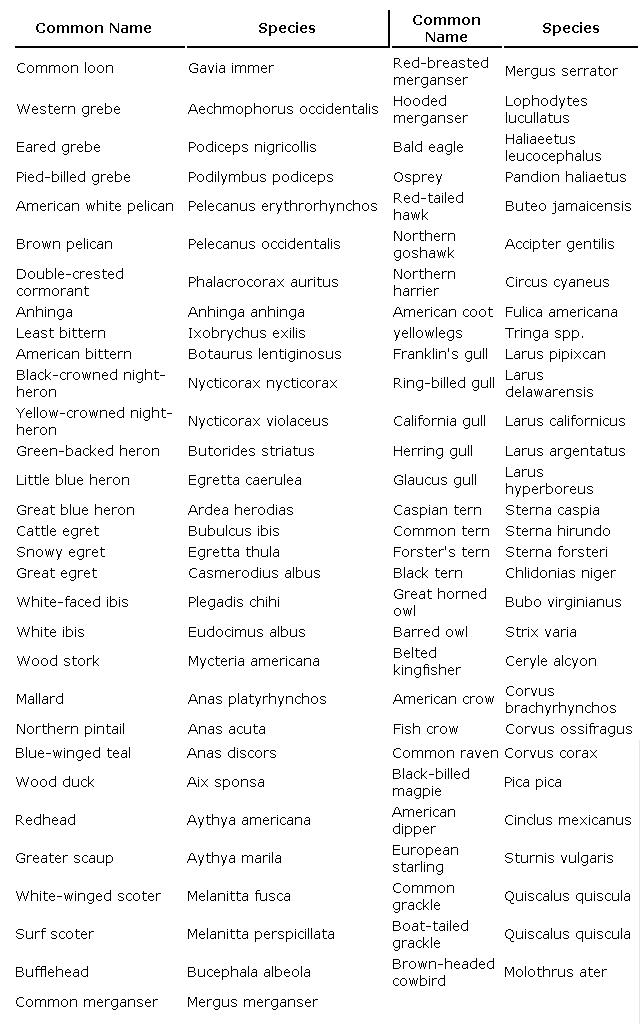
Identification
Reduction of the damage
caused by fish-eating birds requires accurate bird
identification and some knowledge of avian biology and
habits. Responsible bird management requires knowledge
of both the problem species and other birds that use the
aquatic habitat without harming aquaculture efforts. Not
all birds are harmful to production efforts. Birds only
become a problem if their activities directly or
indirectly result in fish loss. Many species benefit
from the association with production facilities without
interfering with production efforts.
Table 1 lists 61 species
of birds reported as pests at aquaculture sites. Table 2
presents a brief description of the appearance,
characteristic feeding habits, and behavior of birds
responsible for damage. Although some birds are limited
in the way they feed and may be easily deterred by
control measures, many birds have a repertoire of
feeding behaviors available to overcome various damage
reduction schemes. As an example, Table 3 illustrates
the variety of feeding behaviors used by six species of
herons.
Damage and Damage Identification
The open-water areas and
large concentrations of aquatic livestock at aquaculture
facilities are natural attractants to many birds. Birds
can have a significant economic impact on the culture of
aquatic products including fish, shellfish, crustaceans,
and other invertebrates. For our purpose here, we will
refer to these birds as fish-eating birds, and the
aquatic products as fish.
Table 2. Identification
and description of the feeding habits and behavior of
birds commonly responsible for damage at aquaculture
facilities.
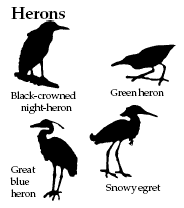 Herons Herons
Description: Body length varies, 11 to
38 inches (28 to 97 cm).
Long legs and toes, short tail, large wings.
Wingspan varies; great blue heron, 70 inches (178 cm);
black-crowned night-heron, 44 inches (112 cm); snowy
egret, 38 inches (96 cm); green-backed heron 25 inches
(64 cm).
Neck usually long, bent in S shape when flying; beak
long, pointed.
Plumage variable: all white, brown, gray, blue; or
pattern of stripes and streaks.
Sexes colored alike; immatures duller than adults.
Feeding and Other
Habits:
-
Various methods used
depending on species. See Table 3 for more details.
-
Feed mostly during day
or at dusk; black-crowned night-herons feed mostly
at dusk or night. Most nest in colonies; often perch
or nest in trees near water.
-
Depending on species,
hunt singly but can occur in large, loose flocks
that tend toward even distribution across foraging
area.
-
Foraging birds attract
others.
 Cormorants Cormorants
Description: Five species in North
America; double-crested cormorant described below is a
major pest at aquaculture facilities.
Body length 32 inches (81 cm).
Wingspan 52 inches (132cm).
Plumage uniformly dark, with large, orange throat patch;
young with lighter underparts.
Sexes colored alike. Short legs and webbed toes; short
tail often used as prop when perched.
Wings with body often nearly submerged, but with neck
erect and bill pointed at upward angle.
Feeding and Other
Habits:
-
Dives from surface;
pursues fish underwater.
-
Daytime feeder; hunts
singly or in flocks that may number 500 to 600
birds. Birds in feeding flock form line that
advances on fish.
-
Foraging birds attract
others.
-
Runs across water to
take off.
-
Nests in colonies;
often perches on trees, poles, rocks, or buoys that
overhang or project from water.
 GULLS GULLS
Description: Many species; in general,
stout body, total length 12 to 32 inches (30 to 81 cm).
Long, pointed wings; wingspan 36 to 65 inches (91 to 165
cm).
Bill slightly hooked; webbed feet.
Adult plumage mostly white, wings white or dark on upper
surface with dark tips.
Immatures darker, mostly brown or grayish.
Sexes colored alike.
Feeding and Other
Habits:
-
Variable methods:
plunges from flight, perches on raceway walls;
swoops down to scoop up prey; bobs while swimming.
-
Forages along
shoreline; scavenges dead fish.
-
Daytime feeder.
-
Highly social; breeds
in colonies.
-
Feeds in flocks.
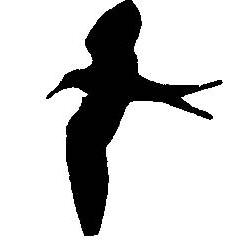 Terns Terns
Description:
Streamlined, slender body, total length 9 to 23 inches
(22 to 58 cm).
Long, pointed wings; wingspan 20 to 53 inches (51 to 135
cm).
Bill slender, sharp and pointed; tail usually forked.
Plumage mostly whitish with gray on top of wings; black
cap present except in winter.
Sexes colored alike.
Feeding and Other
Habits:
-
Foraging birds attract
others.
-
Flies over water,
hovers above surface, dives head-first into water.
-
Daytime feeder; hunts
individually.
-
Nests in colonies;
does not normally swim.
-
Light, graceful flier.
 Mergansers Mergansers
Description: Three species in North
America: hooded, red-breasted, and common mergansers.
Body length varies: hooded merganser 16 to 19 inches (41
to 48 cm); larger species 20 to 27 inches (51 to 69 cm).
Wingspan from 26 to 37 inches Slender, spike-like bill
with hooked tip.
Crested head except for male common merganser. s (66 to
94 cm).
Plumage varies with sex: males at distance appear mostly
black and white; females appear gray and brown.
Feeding and Other Habits:
-
Dives from surface;
pursues fish underwater.
-
Daytime feeder.
Normally in small, loose flocks; large
concentrations unusual.
-
Runs across water to
take off.
-
In flight, body, head,
and neck are horizontal.
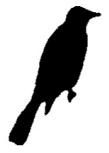 Blackbirds Blackbirds
Description: Many species: in general, small-bodied,
total length 6 to 16 inches (15 to 40 cm); sharp,
pointed bill.
Plumage iridescent black; some species have brightly
colored areas of yellow, red or orange on head or wings.
Females smaller-bodied; plumage brownish, often with
streaked breast.
Feeding and Other Habits:
-
Catches prey in
shallow water at impoundment edges, or climbs down
raceway screens to water surface.
-
All species daytime
feeders.
-
Gregarious; flocks
number from few birds to thousands.
-
Some species
congregate in huge winter roosts.
 Belted
kingfisher Belted
kingfisher
Description:
Compact body, total length 12 to 13 inches (30 to 33
cm).
Large head, short neck, heavy pointed bill.
Short legs and toes; wingspan 21 to 24 inches (53 to 63
cm).
Plumage blue-gray above; males with gray band across
white breast, females with gray and rusty band.
Head crested.
Feeding and Other
Habits:
-
Plunge-dives head
first from perch or hovering position.
-
Daytime feeder.
-
Territorial and
solitary.
-
Loud rattling call
given in flight.
-
Uses poles, wires, and
other elevated objects as perches to scan foraging
areas.
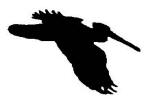 Pelicans Pelicans
Description:
Two species in North America: American white pelican described
below is pest species at aquaculture sites. Body length
62 inches (158 cm). Wingspan 108 inches (274 cm).
Very large white bird with black wing tips and enormous,
orange bill with pouch.
Sexes colored alike.
Young grayish colored.
Swims with great buoyancy; floats high on water.
Feeding and Other
Habits:
-
Feeds from water
surface; does not dive.
-
Plunges head
underwater and catches fish in pouch.
-
Daytime feeder; hunts
singly in deep water; in shallow water forms small
flocks that drive fish toward shore.
-
Takes off from water
with feet kicking in unison.
-
Nests in colonies
usually at sites remote from people.
-
In flocks most of
time; flies with series of slow wing beats followed
by glide.
-
Birds in flock fly
single file; may soar to great heights.
Table 3. Occurrence of
feeding behaviors among selected species of herons (from
Kushlan 1978).
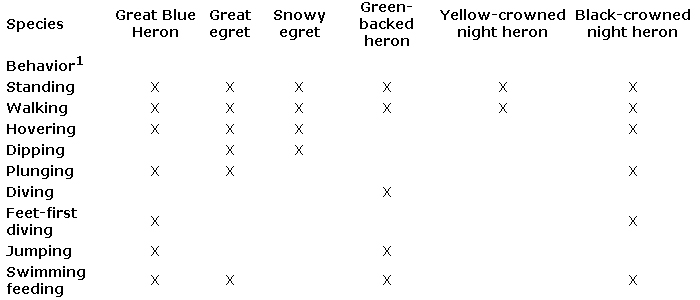
1Feeding behaviors defined
as follows:
Standing - stands in one
place.
Walking - walks at a slow or fast speed.
Hovering -hovers over water or ground, picking up prey.
Dipping - while flying puts head down and catches prey.
Plunging - dives headfirst from air.
Diving - dives headfirst from perch.
Feet first diving - alights on water feet first.
Jumping - jumps from perch feet first.
Swimming feeding - swims or floats on surface of water.
Fish-eating birds are
highly mobile and adaptable predators, able to rapidly
exploit situations of food abundance. Aquaculture
facilities are ideal feeding sites for these predators.
The severity of bird problems will vary with the species
and number of birds present and whether the birds reside
only seasonally or tend to remain at the facility
throughout the year. In recent years, populations of
normally migratory waterbirds have been reported to
remain near fish production facilities year-round. The
proximity of nearby nesting or roosting sites and the
availability of alternative feeding sites are also
important factors. Problems are compounded when drought
impacts alternative feeding sites, especially as the
number and size of available wetlands continue to
diminish due to human activities.
Besides consuming fish,
birds can injure fish, disrupt their feeding activity,
disturb broodstock, and contribute to the spread of
diseases and parasites in aquaculture ponds and
raceways. In marine environments, large numbers of birds
often roost on shellfish culture or holding structures.
Shellfish lots have failed to meet coliform bacteria
standards set by health service agencies due to fecal
droppings of birds roosting on these structures. Bird
feces can degrade water quality and, through bacterial
activity, leads to reduced oxygen levels. The economic
impact on the farmer can be extensive and, in some
cases, devastating. Bird depredation results in loss of
crop and income. It can result in significant
expenditure of time and funds in establishing bird
management programs and training personnel.
The birds commonly
responsible for most damage are herons, cormorants,
pelicans, gulls, egrets, mergansers and other diving
ducks, blackbirds, and kingfishers. Other problem
species reported less frequently include dippers,
grebes, ospreys, and dabbling ducks. Because most
species of fish-eating birds are diurnal, or active
during daylight hours, direct observation is the usual
means of confirming bird presence and damage. Obvious
signs of hunting and feeding birds include birds perched
on trees or wires near raceways or ponds, hovering
overhead and then plunging into the water, standing or
stalking along the edges of ponds, or swimming and
diving in the ponds. Some species, including the
black-crowned night-heron and the yellow-crowned
night-heron in particular, feed at dusk and night, when
aquaculture personnel may not be present to observe
damage. Because most fish are swallowed whole, often few
direct signs of damage are left behind. The decrease in
the number of remaining fish may not be obvious for some
time. In these cases, the presence of whitewash (bird
excrement), bird feathers, and/or bird footprints may be
the only signs of bird predation. Additional
observations at night should be made to verify bird
depredation. Some fish may show scars from predatory
attempts. Cormorants often injure fish, allowing access
to fungal and bacterial disease organisms. Herons
sometimes spear but do not kill or eat larger brood
stock. Chewed or partially eaten fish may be a sign of
predatory mammals, including raccoon, mink, and otters.
Legal Status and Permit Protocol
Resolution of bird
depredation problems is complicated. All fish-eating
birds that frequent aquaculture facilities are
classified legally as migratory and thus are protected
by federal, and in most cases, state laws. These laws
were developed to protect US interest in migratory birds
in concert with the interests of other nations that
provide habitat to these same avian populations. The
Migratory Bird Treaty Act (16 USC 703-711) consists of
agreements made with foreign governments concerning
migratory species and influences US domestic laws and
regulations concerning these species.
Because of the economic
loss caused by birds, a grower’s first reaction often
includes lethal action. Lethal control, however, is not
allowed without a permit. Permits to use limited lethal
action against depredating birds may be granted, but
only after nonlethal techniques, have been used
correctly, and after qualified USDA-APHIS-ADC personnel
verify that these methods need to be reinforced by use
of lethal methods. A permit is not needed to physically
or mechanically exclude any fish-eating bird from
raceways or water impoundments. Except for threatened or
endangered species such as the bald eagle, a permit is
not required to harass or scare fish-eating birds.
The USDA-APHIS-ADC
recommends the following procedure when an aquaculture
facility is experiencing damage from migratory birds.
(1) Contact the
appropriate wildlife damage control biologist employed
by the USDA in your region of the state. Assistance may
be provided by the state office of the USDA-APHIS-ADC
program listed under the federal government in the
telephone directory.
Table 4. Control methods
most often used for various bird species. Effectiveness
is variable, and a combination of methods is often
necessary.
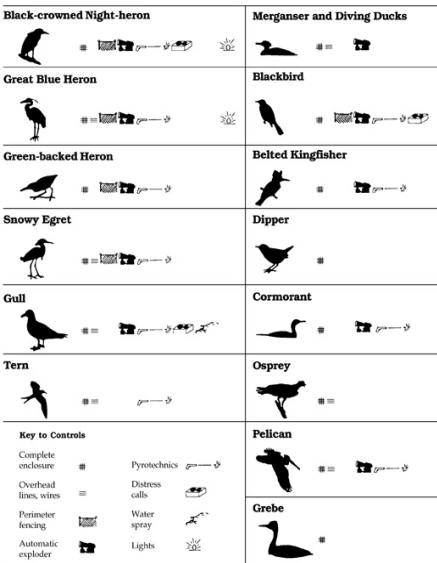 Exclusion Exclusion
Exclusion is the complete
enclosure (caging) of ponds and/or raceways with screen
or net. It is effective for small facilities, but is not
practical, however, for protecting most ponds larger
than 5 acres (2 ha).
Total exclusion is the
only legal method available that provides complete,
long-term control. Complete screening or netting is
effective in excluding all problem birds and has been
adopted by a number of state and federal hatcheries.
Some commercial producers have adopted complete facility
exclosure or partial exclosure in combination with other
management practices. This choice is based primarily on
the monetary damage caused by the birds and/or
self-protection from potential legal consequences
associated with migratory, threatened, and endangered
bird species.
Selection of a barrier
system depends on the problem bird species and expected
duration of damage, size of facility, and whether the
barrier will interfere with other operations. Other
considerations include possible damage from severe
weather and the barrier’s effect on site aesthetics in
visually sensitive areas. Any physical barrier control
system must be constructed so that it does not become a
lethal object to birds, especially to threatened and
endangered species. The barrier should be visible to
birds to minimize accidental entrapment and/or injury.
Avoid using loosely hung, small mesh netting such as
mist netting, as it will cause excessive bird loss and
draw public and regulatory attention.
Conduct a thorough
benefit-cost analysis when considering complete
enclosure. The initial capital cost for complete
exclusion is often justified over time by reduced fish
loss, less need for active control measures, and
avoidance of expensive legal entanglements. The
availability of relatively inexpensive, light-weight
plastic netting and the developing technology to net
large areas of 20 acres (8.1 ha) or more may reduce
costs considerably.
In general, enclosing
ponds and raceways to exclude all fish-eating birds
requires 1- to 2-inch (2.5- to 5-cm) mesh netting
secured to frames or supported by overhead wires (Fig.
2). Gates and other openings must also be covered (Fig.
3). In areas with harsh winter conditions, an adequate
framework or support cables must be provided to prevent
ice or snow accumulation from ripping the netting.
Technical considerations applicable to netting large
impoundments are provided by Martin and Hagar (1990).
Some hatchery operators
use mesh panels placed on the raceway walls above the
water to effectively exclude birds. Install small mesh
wire or net less than 1 inch (2.5 cm), secured to wood
or pipe frames to prevent feeding through the panel.
Design panels to accommodate demand or automatic feeders
and feed blowers that feed through mesh-covered
raceways.
All exclusion structures
must be strong enough to prevent the weight of large
birds and their activities from sagging the net to
within feeding distance of the water. Since panels may
interfere with feeding, cleaning, or harvesting
operations, they may be more appropriate for seasonal or
temporary use.
Construct all exclusion
structures to allow use of fish maintenance equipment
and, if necessary, to withstand wind and the
accumulation of snow and ice. Nonrigid exclusion
structures such as suspended netting may need lines,
pulleys, and counterweights to facilitate lifting and
lowering during adverse conditions or maintenance.
Impediments
Impediments are partially covered systems with
overhead wire, line, net, or screen, and devices that
discourage birds from entering a feeding zone or
perching nearby.
Impediments such as
overhead lines are usually less expensive than
enclosures, but do not exclude all bird species. For
example, properly spaced overhead wires or lines can
effectively deter most gulls, mergansers, and terns, but
screening or netting is required for smaller birds such
as kingfishers or birds that land beside and then walk
into impoundments.
Overhead Wires or Lines.
Ponds or raceways can be covered with overhead lines of
braided or other extruded polypropylene material, or
stainless steel wire, suspended horizontally in one
direction (Fig. 4) or in a crossing pattern. These lines
should be made visible to the birds by hanging streamers
or other objects at intervals along the wires. The
objective is to discourage bird feeding activities and
not cause bird injury or death. Overhead wire networks
generally require little maintenance other than
maintaining proper wire tension and replacing an
occasional broken wire. Reflecting tapes are also used
in overhead networks, but they are prone to wind damage.
Spacing between wires or
lines varies with the species. Overhead lines have been
most successful with gulls. Various designs have been
effective in creating a psychological barrier for gulls
at reservoirs, nesting areas, outdoor restaurants, and
hatcheries. Amling (1980) repelled gulls from reservoirs
with wires 8 to 10 feet (2.4 to 3 m) above the water and
spaced at 50- to 80-foot (15 to 24-m) intervals.
Ostergaard (1981) excluded gulls from a hatchery using
fishing line spaced at 16-inch (41-cm) intervals, 8
inches (20 cm) above the water. The lines were attached
to S hooks so they could be removed as needed. A 4-foot
(126-cm) spacing has also deterred gulls. Two-foot
(63-cm) spacing is necessary to exclude mergansers, and
a 1- to 2-foot (30- to 61-cm) spacing is required for
great blue herons or Forster’s terns. Birds sometimes
enter the system through sides or ends where wires
attach to buildings, so these areas should be protected
with netting (Fig. 5).

Fig. 2. Complete enclosure

Fig. 3. Curtain-type gate for access to completely
enclosed area.
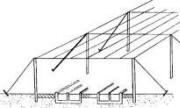
Fig. 4. Overhead lines or wires
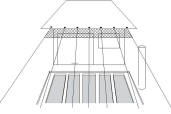
Fig. 5. Netting where wires attach to building prevents
birds from walking down the roof and jumping through the
wires into the facility.
Some birds have adapted to
overhead lines. At a California fish hatchery, overhead
lines deterred gulls (but not herons) for years until
one gull landed beside a raceway and walked in from the
side. As more birds exhibited this learned behavior, the
overhead lines had to be replaced with netting. Overhead
lines have also been ineffective on cormorants. Flocks
at a test site were deterred by overhead lines, but
individual birds learned to avoid the lines 1 foot (0.3
m) above the water when landing or taking flight and
continued to cause serious damage (Moerbeek et al.
1987).
Fig. 6. Wires and fence
protect side.
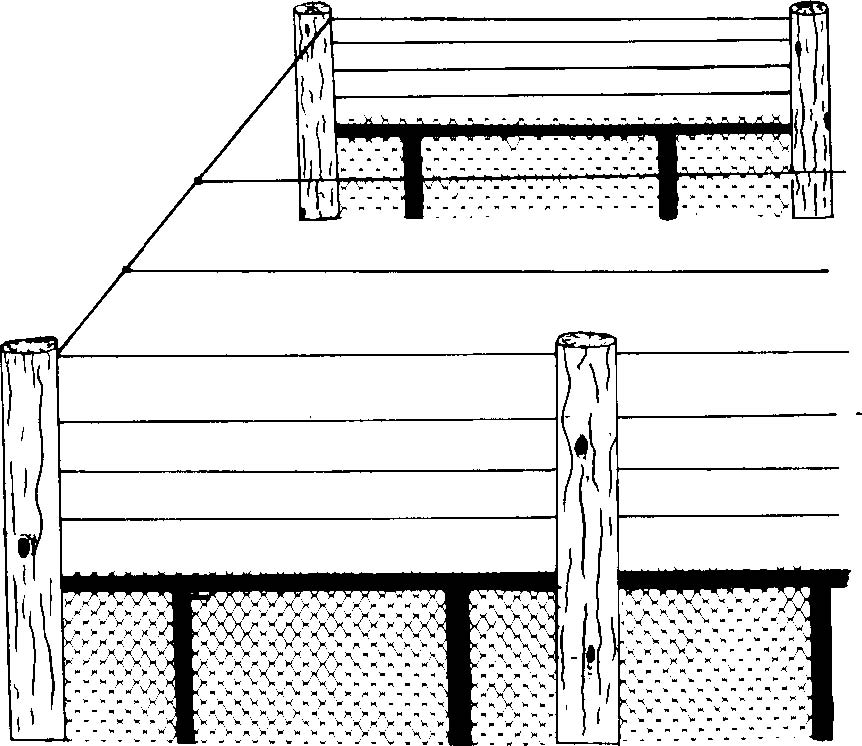
Fig. 7. Example of a
2-strand fence with wires at 8 and 14 inches
supplemented with polyethylene floats spaced less than
12 inches apart around the pool edge.
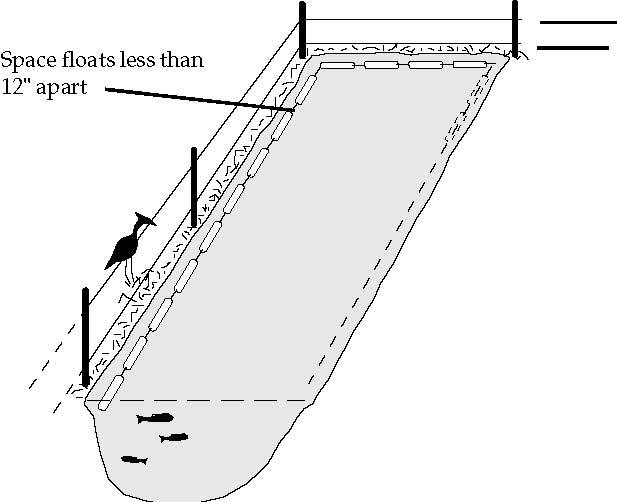 14"
8" 14"
8"
the system from becoming
grounded, commonly caused by vegetation interference and
blowing debris. Wires are strung on supports that
suspend the wire over the water’s edge near the natural
shelf that often forms in shallow areas of the pond
margin. This system discourages wading birds from
feeding on fish while walking along the shelf.
Metal Spines. For some
situations, sharp, metal spines, sometimes called
porcupine wires (Nixalite® and Cat Claws®) may be used
to deter perching and roosting by birds. Such devices
have been employed on shellfish racks and floats that
hold and maintain shellfish stocks. The spines prevent
birds from settling on the growout or holding
structures, and the shellfish are protected from fecal
contamination by the birds. These devices are used on
fish farms to prevent birds from perching on a structure
near the water.
Homemade versions of these
commercial products can be built by hammering nails
through wood lath and attaching the lath at the
appropriate location (Fig. 8). Poles or posts may be
guarded against perching birds by sharpening the end, by
insertion of a guard spike, or by use of a sheet-metal
cone over the end (Fig. 8). These devices are useful in
discouraging species that hunt from an elevated perch or
at roosting sites where fecal deposits are unacceptable.
Cultural Methods
Facility Location. The physical
location, design, and construction of an aquaculture
facility influence the susceptibility of fish to bird
predation. Although water availability, water quality,
and other parameters essential to fish production are
prime considerations in site selection, locations away
from obvious bird concentrations should also be
considered. Facilities located in close proximity to
rivers, roosting areas, marshes, and other wetlands will
result in increased interaction with bird populations.
Close proximity of rookeries and wetlands designated for
protected and sensitive species, and flyways where
sensitive species frequent, also increase chances for
negative impacts from bird predation and associated
legal problems.
Facility Design.
Facility design also influences success in protecting
aquatic products from birds. Complicating this issue are
the aquaculture species produced and the type of
facilities best suited for production of a given
species. For example, intensive, compact raceway systems
characteristic of the trout industry are more easily
protected than large, extensive ponds used for many
warm-water species.
Production systems should
be constructed to discourage bird/fish interaction and
limit birds’ access to fish. With the exception of total
exclusion, such as a caged facility, no single method
can be used in large pond systems to alleviate all bird
activity. More practical approaches include a
combination of facility design and management practices
to discourage certain bird behavior in some areas, and
exclusion of birds from the most vulnerable aspects of
the production system.
Size and shape of ponds
influence the effectiveness of some control methods.
Rectangular, smaller ponds are recommended. Scare
techniques are more effective due to birds’ proximity to
shore. Ponds should be a minimum of 3 feet (1 m) deep to
discourage wading birds such as herons and egrets. Pond
bank margins should be fairly steep, necessitating
compaction of heavy clay
Fig. 8. (a) Spike and wood
lath installation along top of pipe framework to deter
fish-eating birds;
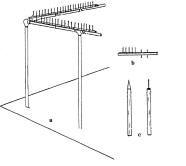
(b) details of spikes and
wood lath; (c) posts guarded against perching birds by
use of a sheet-metal
cone over end (left) or
guard spike (right).
or other material to
minimize erosion. Banks and levees should be clear of
tall vegetation that could provide cover for birds. If
possible, the site should not have structures such as
telephone or light poles, or vegetation that provide
roosts or perches.
Concrete raceways and tank
systems with straight, vertical walls are more easily
protected than earthen systems. Water depth should be at
least 3 feet (1 m) and the water level maintained 2 to 3
feet (0.75 to 1 m) below the wall surface in uncovered
systems to discourage feeding from the walls.
Tank and raceway systems
are the most easily and economically covered, and this
may be the most practical approach to avoid damage.
Tanks and raceways may be covered individually or caged
in units that allow access and operation of equipment.
Most operators of covered facilities feel that the extra
expense of covering at a height that allows the
operation of equipment under one cover is quickly made
up by the savings from the labor cost of operating
individually covered systems. Associated hatchery
buildings and nursery tanks should also be protected by
exclusion techniques to prevent birds from entering a
hatchery building and feeding from tanks and troughs.
Again, the decision as to the extent of facility caging
should be based on the extent of bird damage and legal
sensitivity experienced annually, weighed against
capital expense and annual operational cost.
Fish Management.
Fish management and the ability to adjust programs based
on changing bird habits are as important as facility
design. Since fingerlings are more susceptible to bird
predation, they should be located close to the center of
human activity and near buildings that might be
incorporated in a bird exclusion system. Larger fish
usually need less protection because they are better
able to avoid bird predators. A compromise strategy is
to concentrate the more susceptible fingerlings under
nets covering smaller ponds, and use larger ponds and an
intensive bird harassment program to protect the larger
fish. Problems have become so severe for some ornamental
and baitfish producers that they have adopted complete
exclusion techniques.
Studies indicate that
birds are more likely to feed on ponds that are heavily
stocked with fish than in ponds with moderate stocking
rates. Reducing stocking rates may make ponds less
attractive to depredating birds.
Feeding techniques may
also influence the effectiveness of bird management
programs. Floating rations produce surface feeding
activity among fish that aids the grower in monitoring
fish health, but this activity may also attract gulls
and mallards that consume the floating food and feeding
fish. The activity of these birds often attracts other
fish-eating birds to the pond. The advantages of using
floating rations should be weighed against the problems
they may cause.
In addition, surface
feeding species are more difficult to protect than
species that can feed on the bottom, and some ornamental
species are harder to protect than less visible animals.
It is important to monitor
water quality in fish-rearing facilities. Low dissolved
oxygen levels may force some fish species near the
surface, making them more vulnerable to predation.
Frightening
Frightening devices and techniques modify behavior
and discourage birds from feeding, roosting, or
gathering at a location.
Many visual and
sound-making devices are commercially available for
scaring birds. These include gas-operated exploders,
pyrotechnics, electronic noisemakers, bird distress
calls, standing or pop-up effigies, eyespot balloons,
raptor models, strobe or flashing lights, reflective
plates or lines, and water spray devices.
The value of these devices
is usually limited to short-term control. Although bird
damage can sometimes be reduced by using only one type
of frightening device, better results over longer
periods are often achieved by using a combination of
devices and/or by changing methods frequently. In
addition, scaring equipment, especially sound-making
devices, is usually more effective when moved often to
prevent birds from becoming accustomed to the device.
Birds will eventually ignore any scaring device that is
left in the same place or that emits sound in the same
regular pattern over a long period of time.
It is important to start
the frightening regime before the birds establish
regular feeding patterns at a site. Once regular habits
are established, they are difficult to break using
frightening techniques. Although the majority of birds
may be scared away initially by frightening methods,
some individuals will soon ignore the control methods.
These “hard-to-scare” individuals attract others to the
feeding site. These birds require a control method
involving real danger from the bird’s point of view,
such as pyrotechnics or exploders, reinforced by human
presence. The effectiveness of frightening devices can
be improved by incorporating the use of rifles or
shotguns to remove birds (with permit) that have
habituated.
Because of all the
variables involved, the success of a frightening program
is dependent on the skill and motivation of the
operator. Frightening devices will not be effective
unless used aggressively in a carefully planned program.
Bird dispersal patrol
teams can be used to harass and frighten birds in the
immediate area of larger aquaculture facilities. Patrols
must be adequately equipped with radio-equipped
vehicles, bird distress calls, shotguns, live
ammunition, and pyrotechnics. Patrol personnel must be
trained in bird identification and dispersal methods.
Blackbirds, cormorants,
herons, and other species establish roosts, especially
during winter, that include many individuals (hundreds
of thousands in the case of blackbirds). These birds may
cause significant losses if they feed in aquaculture
facilities. Frightening devices and cultural methods can
be used to drive depredating birds from the area. See
the Bird Dispersal Techniques chapter for specific
information on roost dispersal.
Choosing the most
effective combination of frightening devices requires
careful consideration. One must match the devices to the
bird species causing damage, assess the cost of the
equipment and labor requirements, and consider possible
interference with culture operations. For example, loud
noises disturb spawning catfish. They may also disturb
neighbors or others near the aquaculture site.
Automatic Exploder.
The automatic exploder resembles a small cannon. It
commonly operates on propane gas or acetylene and emits
loud explosive blasts at adjustable time intervals.
While the number of exploders necessary will vary from
site to site, one exploder can usually cover 3 to 5
acres (1.3 to 2 ha) if used properly and reinforced with
other control techniques. Explosion frequency is
important since short intervals increase the chance that
birds will become accustomed to the sound. Timers that
automatically start and stop the operation to produce
irregular explosion intervals, and rotary mounts that
change the direction of the sound after each explosion,
improve the effectiveness of the device. For best
results, move exploders every 1 to 2 days to a different
part of the facility. If necessary, elevate them to
prevent foliage or adjacent equipment from interfering
with sound projection. Exploders have been effective for
herons, egrets, cormorants, diving ducks, and
blackbirds.
Pyrotechnic Devices.
Harassment of birds can be accomplished by firing
shellcrackers from a 12-gauge shotgun. These shells
contain a firecracker that is projected 50 to 100 yards
(45 to 90 m) before exploding. Since wads from the shell
may stick in the gun, it is important to check the
barrel after each shot and to regularly clean the gun.
Breech opening, open-bore shotguns are required.
Other pyrotechnic wildlife
dispersal devices, variously known as noise, bird, clow,
racket, or whistle bombs, noise rockets, or bird
whistles, are among the most effective scaring devices.
Though the range of these projectiles is only 35 to 75
yards (33 to 69 m), they are less expensive and more
convenient to handle than shellcrackers. A recent study
in Colorado using these handheld devices significantly
reduced damage by great blue herons and black-crowned
night-herons (W. F. Andelt, personal communication).
Possession and use of pyrotechnics may require a permit
from the local, county, and/or state fire marshal.
Blackbirds and grackles have been effectively frightened
by .22caliber birdshot.
Alarm or Distress Calls.
Many species of birds emit calls that communicate alarm
or distress to other birds of the same species.
Broadcasted recordings of these calls can frighten and
repel some bird species. Reaction to the calls varies
with species of bird, location, size of area, and time
of year. For best results, broadcast distress calls as
birds begin to arrive. A timing device can be used to
play calls at predetermined intervals. Lengthen the time
between broadcast intervals as much as possible while
still achieving the desired response. Birds habituate to
distress calls if they are played frequently or over a
long period in the same location. Thus, calls need to be
reinforced by other methods. Alarm calls have been used
successfully on black-crowned night-herons, gulls, and
blackbirds.
Lights. A variety
of lights, including strobe, barricade, and revolving
units, have been used to frighten birds with mixed
results. Of these, strobe lights similar to those used
on aircraft are most effective in frightening
night-feeding birds. These extremely bright flashing
lights have a blinding effect, causing confusion which
reduces a bird’s ability to catch fish. Black-crowned
night-herons, however, may avoid the bright glare by
landing with their backs to the lights or by moving to
less well-lit areas. Avoidance may be minimized by
increasing the number of lights to cover the unprotected
areas.
Flashing amber barricade
lights, like those used at construction sites, and
revolving or moving lights may also frighten birds when
these units are placed on raceway walls or fish pond
banks. Most birds, however, rapidly become accustomed to
such lights, and their long-term effectiveness is
questionable. In general, the type of light, the number
of units, and their location are determined by the size
of the area to be protected and by the power source
available.
Water Spray Devices.
Water spray from rotating sprinklers placed at strategic
locations in or around ponds or raceways will repel
certain birds, particularly gulls (Svensson 1976).
Individual birds may become accustomed to the spray and
feed among the sprinklers. Best results are obtained
when sufficient water pressure is used and the
sprinklers are operated on an on-off cycle. The sudden
start-up noise also helps to frighten the birds.
Ultrasonics. In
general, birds do not hear in the ultrasonic range and
fish-eating birds have not been shown to be repelled by
ultrasonics.
Raptor Models.
Strategic placement of owl decoys or raptor silhouettes
has been used to discourage roosting of pigeons and
other perching birds. For best results, models or decoys
require frequent relocation, but their effectiveness is
more often short-term.
Effigies and Scarecrows.
Scarecrows and other human and animal effigies have had
limited success in deterring birds. Pop-up models and
models that show activity and produce a sound have shown
some success on herons, ducks, and cormorants, but all
require frequent relocation.
Aircraft.
Ultralight aircraft have been used by producers to
intercept large flocks of birds and herd them away from
commercial facilities. This has been most effective with
large concentrations of pelicans. Both this and
ra-dio-controlled model airplanes and model raptors have
been used but are expensive, subject to weather
conditions, high winds, and in the case of ultralights,
may place humans at risk. They also may not be effective
on species that seek safety by diving underwater.
Chemical Frightening Agents.
Avitrol® is registered for
use on herring gulls and blackbirds. For herring gulls,
Avitrol® is applied to a bread bait; for blackbirds,
several grain formulations are available (corn, sorghum,
wheat, and mixed grains). The bait is lethal to the bird
ingesting it, and the afflicted bird’s erratic behavior
and distress and alarm calls will frighten away other
birds in the flock. Mortality is minimized by limiting
the amount of bait offered. For further details on the
use of Avitrol® see the Blackbirds, Starlings, or
Pigeons chapters. State and federal permits are required
to use Avitrol® on gulls.
Sooting is illegal to trap
or shoot all of the fish-eating birds described in this
chapter (except blackbirds), without a permit from the
US Fish and Wildlife Service. A permit is normally
issued only to augment nonlethal methods. There may be
additional state permits required. Blackbirds may be
trapped and/or shot (see Blackbirds). Check with the
state agriculture or wildlife department or
USDA-APHIS-ADC before shooting or trapping birds that
are causing damage at aquaculture facilities. Waterfowl
(mallards, mergansers, and other ducks) may be legally
hunted during the hunting season. A hunting license and
federal duck stamp are required. In some areas, a state
duck stamp is also required. Check state hunting
regulations and local ordinances before discharging
firearms near buildings or roads.
Economics of Damage and Control
The cost of bird damage to
aquaculture can be difficult to quantify. Losses of
stock can be due to cultural, mechanical, or
environmental factors, in addition to predators.
Identification of any single cause of loss is not always
possible, and the total loss may not be known until
harvest. There are data on the potential spread of
disease by birds, but documented cases are rare because
the size and nature of most aquaculture facilities
preclude removing variables as required for controlled
disease studies. The costs of control, however, are
becoming available from grower surveys, and estimates of
loss can be projected from food habit studies.
Loss estimation requires
knowledge of the species and numbers of birds present,
the length of time present, the amount of fish taken
daily, and the value of the crop. Based on esophageal
and stomach contents of four species of herons, Hoy et
al. (1989) found that losses of golden shiners in
Arkansas ranged from $0.10 to $1.12 per feeding. A flock
of 100 wading birds present for a 3-month period could
result in losses from $1,800 to $11,160, depending on
the species composition. A flock of 2,000 birds, common
at some sites during fall migration, could cause a loss
of $20,000 in a 2-week period. Stickley and Andrews
(1989) estimated the loss of catfish to double-crested
cormorants in Mississippi at $3.3 million. A survey of
Mississippi growers indicated that they spent an average
of $7,400 per year on bird control for a total cost of
$2.1 million. In a survey of hatcheries mostly in the
eastern United States, Parkhurst et al. (1987) cited an
average yearly loss per hatchery of about $7,600.
Production increases after
exclusion of a facility have demonstrated the impact of
birds on those facilities. The California Department of
Fish and Game studied two trout hatcheries with long
histories of severe bird problems. In 1979, annual
losses were between $50,000 to $60,000. After exclusion,
production increased 25 to 30% at both facilities. In
these cases, the cost of total exclusion was high, but
the return on investment was realized within 3 to 4
years.
A potential control
program must first compare the anticipated or actual
crop losses to costs and efficacy of damage control
programs. Dolbeer (1981) described a simple process to
assess this benefit-cost ratio. The model is based on
the rule that the dollars saved by reducing damage must
be greater than the costs of control.
Gorenzel et al. (1986)
illustrated the model with an actual bird control
program that used more than one control method. They
discussed the problem of estimating the degree of damage
reduction for a combination of control methods and
suggested approaches to calculate a range of estimated
damage and efficacy values.
Further Assistance
The Animal and Plant
Health Inspection Service (APHIS) of USDA will provide
assistance to aquaculture facilities that experience
losses to birds. If required, on-site advice and
instruction in the actual use of damage control methods
is provided by the APHIS-ADC personnel. Kill permits are
not routinely issued and are contingent on approval from
APHIS and the US Fish and Wildlife Service. For
information concerning assistance, permit applications,
and sources of equipment and supplies, contact the
appropriate state director of USDA-APHIS-Wildlife
Services.
For Additional Information
Amling, W. 1980. Exclusion
of gulls from reservoirs in Orange County, California.
Proc. Vertebr. Pest Conf. 9:29-30.
Blokpoel, H., and C. D.
Tessier. 1984. Overhead wires and monofilament lines
exclude gulls from public places. Wildl. Soc. Bull.
12:55-58.
Bomford, M., and P. H.
O’Brien. 1990. Sonic deterrents in animal damage
control: a review of device tests and effectiveness.
Wildl. Soc. Bull. 18:411-422.
Dolbeer, R. A. 1981.
Cost-benefit determination of blackbird damage control
for cornfields. Wildl. Soc. Bull. 9:44-51.
Gorenzel, W. P., D. B.
Marcum, and T. P. Salmon. 1986. Application of a
benefit:cost model to blackbird damage control in wild
rice. Proc. Vertebr. Pest Conf. 12:269-274.
Hoy, M. D., J. W. Jones,
and A. E. Bivings. 1989. Economic impact and control of
wading birds at Arkansas minnow ponds. Eastern Wildl.
Damage Control Conf. 4:109-112.
Kushlan, J. A. 1978.
Feeding ecology of wading birds. Pages 249-297 in A.
Sprunt, J. C. Ogden, and S. Winckler, eds. Wading birds.
Res. Rep. No. 7. Natl. Audubon Soc., New York.
Martin, L. R. and S.
Hagar. 1990. Bird control on containment pond sites.
Proc. Vertebr. Pest Conf. 14:307-310.
Moerbeek, D. J., W. H. van
Dobben, E. K. Osiek, G. C. Boere, and C. M. Bungenberg
De Jong. 1987. Cormorant damage prevention at a fish
farm in the Netherlands. Biol. Conserv. 39:23-38.
Ostergaard, D. E. 1981.
Use of monofilament fishing line as a gull control.
Progressive Fish Cult. 43:134.
Parkhurst, J. A., R. P.
Brooks, and D. E. Arnold. 1987. A survey of wildlife
depredation and control techniques at fish-rearing
facilities. Wildl. Soc. Bull. 15:386-394.
Peterson, R. T. 1990.
Field guide to western birds. Houghton Mifflin Co.,
Boston. 432 pp.
Peterson, R. T. 1980.
Field guide to the birds of eastern and central North
America. Houghton Mifflin Co., Boston. 384 pp.
Robbins, C. S., B. Bruun,
and H. S. Zim. 1983. Birds of North America. Golden
Press, New York. 340 pp.
Schramm, H. L., Jr. 1984.
Depredation of channel catfish by Florida double-crested
cormorants. Progressive Fish Cult. 46:41-43.
Scott, S. L., ed. 1983.
Field guide to the birds of North America. Natl. Geog.
Soc., Washington, DC. 464 pp.
Spanier, E. 1980. The use
of distress calls to repel night-herons (Nycticorax
nycticorax) from fish ponds. J. Appl. Ecol. 17:287-294.
Stickley, A. R., and K. J.
Andrews. 1989. Survey of Mississippi catfish farmers on
means, effort, and costs to repel fish-eating birds from
ponds. Eastern Wildl. Damage Control Conf. 4:105-108.
Svensson, K. M. 1976.
Rotator for protecting circular fish ponds against
predatory birds. Progressive Fish Cult. 38:152-154.
Related Acts and Bills
Migratory Bird Treaty Act.
(16 USC 703-711). Sec. 703: Taking, killing, or
possessing migratory birds unlawful. Sec. 704:
Determination as to when and how migratory birds may be
taken, killed, or possessed.
USFWS Title 50, Code of
Federal Regulations, Part 21, Migratory Bird Permits.
Revised 9/14/89. 37 pp.
Endangered Species Act of
1973. (As amended by P.L. 94-325, June 30, 1976; P.L.
94-359, July 12, 1976; P.L. 95-212, December 19, 1977;
P.L. 95-632, November 10,
1978; and P.L. 96-159, December 28, 1979.) FWS/LE Law 8,
Revised 6/25/84. 36 pp.
USFWS 50 CFR Part 17.
Endangered and Threatened Wildlife and Plants. FWS/LE
Enf 4-Reg-17. (Revised 1/1/89). 69 pp.
USFWS 50 CFR Part 10.
General Provisions. FWS/LE Enf 4-Reg-10. 15 pp.
Editors
Scott E. Hygnstrom; Robert
M. Timm; Gary E. Larson
PREVENTION AND CONTROL OF
WILDLIFE DAMAGE — 1994
Cooperative Extension
Division Institute of Agriculture and Natural Resources
University of Nebraska -Lincoln
United States Department
of Agriculture Animal and Plant Health Inspection
Service Animal Damage Control
Great Plains Agricultural
Council Wildlife Committee
Special
thanks to:
Clemson University
|